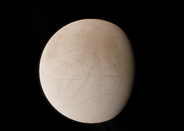Jupiter, sometimes called the Jupiter System or the Jovian System as a whole, is a planetary system in the Sol System centered around the planet of Jupiter. Other notable locations in the Jupiter System include the Galilean Moons of Io, Europa, Ganymede, and Callisto.
Jupiter
Jupiter is the main body of the Jupiter System. It is the largest planet in the Sol System with a diameter of 86,814 miles, approximately 1097% larger than Terra. Jupiter is also the first Gas Giant from Sol.
Physical Characteristics
Jupiter is home to vast clouds and deposits of gaseous Hydrogen and Helium, which could feasibly be extracted in the far future. Jupiter also has a large Magnetic Field 20,000 times stronger than Terra's and with a diameter of almost 3 million miles. Jupiter also has a Planetary Ring System made of dust orbiting it at a height of about 76,000 miles and with a width of about 4,300 miles.
Galilean Moons
Template:Moon InfoboxThe Galilean Moons of Jupiter are a scientific hotspot and some of the most popular locations in the solar system. They are the biggest moons of Jupiter and some of the largest and most prominent in the Sol System.
Io
Io is the second smallest Galilean Moon and the innermost from Jupiter. It is the most volcanically active body in the Solar system with hundreds of active volcanos and lava lakes. It is thought of to be an important spot of research and possible geothermal power source.

Io from orbit, circa 2033 CE.
Europa
Europa is the smallest Galilean Moon and the second innermost from Jupiter. It is home to a vast subsurface ocean with more water than Terra. This fact combined with the discovery of geothermal vents on the ocean floor have prompted most to think that Europa may be home to life. As of 2097, talks have been going through the International Ministry of Universal Sciences and the Terra Pact to declare Europa a Special Research Zone, closed to all human interaction except limited surface exploration and orbital research stations.

Europa from orbit, circa 2097 CE.
Ganymede
Ganymede is the largest Galilean Moon and the second farthest from Jupiter. It is the largest moon in the solar system (not counting Titan's atmosphere) with a diameter larger than Mercury. It is thought of to be a good spot for future research and colonization.

Ganymede from orbit, circa 2068 CE.
Callisto
Callisto is the second largest Galilean Moon and the farthest from Jupiter. It is surrounded by an almost non-existent CO and O atmosphere and is considered the best place in the Jupiter system for a human base due to its distance from Jupiter and its radiation.

Callisto from orbit, circa 2034 CE.
Exploration of the Jupiter System
Discovery and Early Study
Human Civilization has known about Jupiter's existence for thousands of years, but Galileo Galilei, an Italian astronomer, was the first to study the planet in detail. Galileo was also the first to discover and study the Galilean Moons, and it is he who the group finds their namesake.
Robotic Exploration
The first probes to study the Jovian System were the Pioneer and Voyager probes in 1973, 1974, and 1979 CE. They were followed by multiple lander and orbiter probes between 2000 and 2094, the most notable being the Hera Probe, who studied Jupiter's magnetic field in order to test the feasibility to human exploration between 2010 and 2023 CE. Another mission was the IGRS (Io Geothermal Research Survey) Mission, which consisted in an orbiter, lander, and impactor probes which studied Io between 2030-2055.
Manned Exploration
The first manned mission to Jupiter was Galileo 1, launched in 2092 and arriving in 2097 CE. It was the first manned vehicle to land on all four Galilean Moons in June, July, August, and October 2097. It was a benchmark for space exploration and after Galileo 1's return to Terra talks are going through the United Nations Space Administration for future missions and testing for long-term colonization of the Jovian System.

Image from inside Asterius Linea on Europa, one of Europa's most prominent fractures. Circa 2062 CE.
